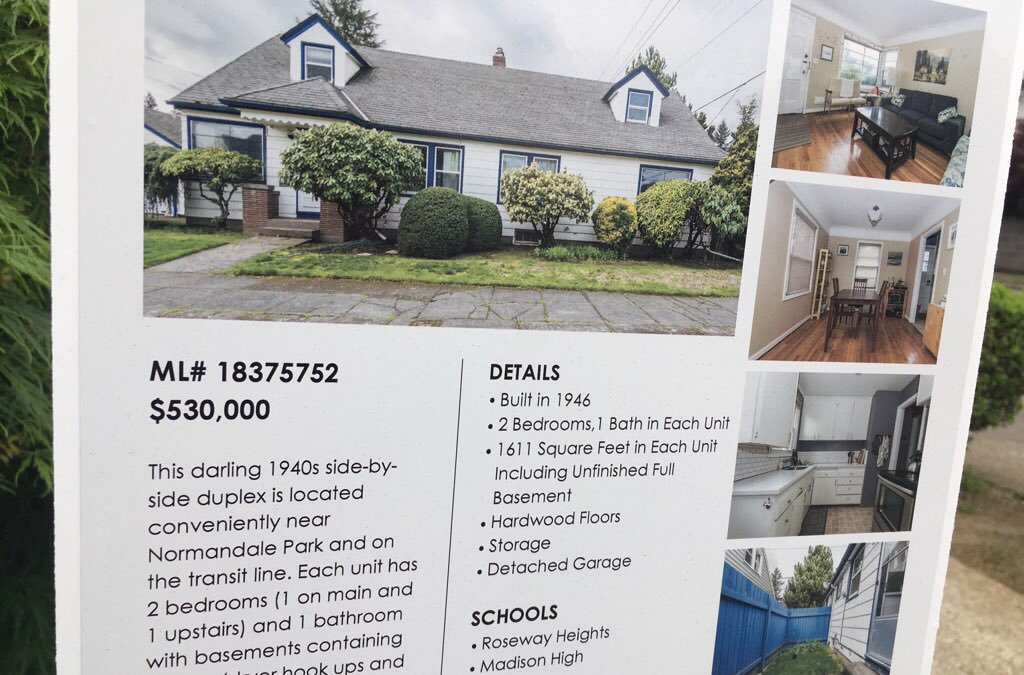Re-legalizing duplexes, triplexes and fourplexes in fancy Portland neighborhoods would create homes with “unaffordable average market-rate rents of $1,823/month,” one resident of a fancy Portland neighborhood warned the Oregon legislature this week.
The home she owns, according to the Multnomah County assessor’s office, is currently worth $529,710. (Approximately equivalent monthly rent: $3,661.)
Other residents made the exact opposite argument.
“I oppose HB2001 as it will make my neighborhood no LONGER a neighborhood but unsightly areas of quickly/cheaply built dwellings (NOT homes),” wrote one man.
As Oregonians debate a bill that would strike down local bans on “middle housing” in the state’s larger cities and other urbanized areas, it can sometimes be easy to lose perspective on one’s place in the world. For people who’ve been blessed by the housing market over the last 20 years, that probably goes double.
READ MORE: ADU Parking Quotas Are Climate Killers
So, what sort of homes is this Cascadian state arguing about legalizing?
Middle-class ones, basically.

Portland’s locally initiated fourplex legalization proposal would be just one of many ways a city could meet the requirements of House Bill 2001, which would let local governments set the size and form of the newly legalized housing types.
It’s already obvious that if we don’t reform zoning one way or another, most of the new homes that get built on redevelopable low-density lots in desirable cities will be only for the rich. But if we’re in search of hard numbers to inform Oregon’s statewide bill, a Dec. 11 presentation about Portland’s proposal is a good place to start.
Under Portland’s plan, a new fourplex on a standard lot could be built to a maximum size of 3,500 square feet, total: four 875-square-foot two-bedroom homes. The city-commissioned analysis found that in a relatively close-in loop of Portland neighborhoods—Eastmoreland, North Tabor, Concordia and Arbor Lodge, as of 2017—a newly built fourplex could command rent of about $1,900 a month for each two-bedroom on the open market.
That’s just 4 percent above the federal affordability standard of $1,831 for a three-person Portland household. In other words: in Portland, legalizing fourplexes would create new homes in these fairly close-in areas that would already be affordable to middle-class Portland households on the day they’re built.
If the homes were subdivided into a little condo building and sold individually, each would go for about $270,375. With 20 percent down and a 4.75 percent mortgage, that leaves a monthly payment of about $1,467 a month for the two-bedroom.
The city-commissioned study calculated that over the next 15 years, the most profitable thing to build on a few hundred low-density lots in that ring of neighborhoods would be 1,179 such homes. (It works out to 20 new fourplexes per year.) Similarly, thousands more homes could be built elsewhere in the city, with higher prices per square foot closer to downtown and lower prices further out.
These homes would, if built and filled, prevent middle-income people from unintentionally buying their way into homes that previously belonged to poorer people. (A different city study released last week estimated that they’d reduce demolition-related displacement of low-income households in affected areas by 28 percent.) To more directly serve deeply disadvantaged households, a zoning reform like this would need to be combined with direct housing subsidies. (Portland’s plan is written to encourage that, too, and other Oregon cities should follow suit.)
But should also remember that this “middle housing” would be affordable to middle-income Portlanders—even in areas where both new and old housing prices have soared far out of reach of the middle class over the last few years—without a dime from city tax coffers.

Cascadia’s cities have been growing fast, and as a result they face lots of housing problems. Middle housing is a solution for one of those problems.
It’s not the only thing we have to do. But it’s not bad, either.
Maybe that’s why, at Monday’s hearing, the supporters lined up for House Bill 2001 included the speaker of Oregon’s House, the Multnomah County chair, AARP of Oregon, Habitat for Humanity of Oregon, The Street Trust, the Mid-Columbia Housing Authority of Hood River and the Rogue Action Center of Medford, not to mention two invited technical experts: Portland State University planning professor Marisa Zapata and housing economist Mike Wilkerson.
Monday’s hearing in Salem was the first of several. You can track it and other state-level housing reform bills in the Pacific Northwest this year by subscribing to our “housing shortage solutions” newsletter here.


Comments are closed.